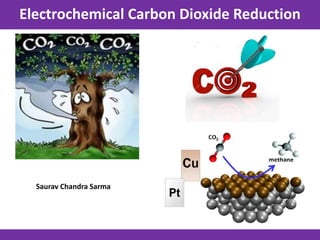
Electrochemical Carbon Dioxide Reduction: Products and Catalysts
- 1. Electrochemical Carbon Dioxide Reduction Saurav Chandra Sarma
- 2. Future Challenges A recent report on the future of carbon dioxide (CO2) emission predicts that in the coming few decades (2010–2060), ~496 gigatonnes of CO2 will be produced because of fossil fuel combustion by existing infrastructure. Solution to the problem • CO2 can be artificially converted into fuel or commodity chemicals. • The CO2 conversion methodology not only addresses the potential solution for controlling the CO2 concentration level in the environment but also offers an alternative approach for conversion of renewable energy to a chemical fuel or product. • So far, various noble metals (Ag, Au, Cu, Pt and so on) and metal complexes are used as heterogeneous catalysts (as electrodes) for CO2 reduction. However, the rising cost of noble metals is the main hindrance towards their large scale practical applications
- 3. Attempts at CO2 reduction M.A Scibioh and B. Vishwanathan, Proc. Indn. Natnl. Acad. Sci., 70 (A), 3, 2004
- 4. Electrochemical Carbon Dioxide Reduction
- 6. Terminology and figures of merit Current Opinion in Chemical Engineering 2013, 2:191–199 • Energetic Efficiency (EE): A measure of the overall energy utilization toward the desired product. • Current Density (CE): A measure of the rate of conversion. • Faradaic Efficiency (FE): A measure of the selectivity of the process for a given product. • Catalyst Stability • Process Costs.
- 7. Product obtained using different metallic electrocatalyst Isr. J. Chem. 2014, 54, 1451-1466 • The first step, generation of CO2 -, is critical because it is the rate limiting step and the coordination of this intermediate determines if the 2e- reduction product will be either CO or formate. • Group 1 consists of those that do not bind the CO2 - intermediate and cannot reduce CO. • Group 2 metals bind the CO2 - intermediate, but cannot reduce CO. • Group 3(copper) binds the CO2 - intermediate and can reduce CO. • There is also another group of metals that bind hydrogen strongly, thereby excluding CO2 reduction in aqueous media.
- 9. Proposed Protocol Clean Techn Environ Policy (2015) 17:533–540
- 11. E (vs.RHE) = E (vs. Ag/AgCl) + 0.1988 V + 0.0591 V pH Converting the reference scale from Ag/AgCl to RHE
- 13. The faradaic efficiency for the formation of formate (f) is calculated as follows: where 2 represents the number of electrons required for the formation of one molecule of formate from CO2; n is the moles of the formate produced; F is Faraday's constant (96485 C mol1 of electrons); and Q is the total charge in Coulomb passed across the electrode during the electrolysis
- 20. Formation of different products • Faradaic efficiency of CO was 21.5% at -1.73 V vs.Ag/AgCl, which was more positive potential than those reported previously. • Faradaic efficiency for methanol (1-2.5%) is about ten times higher compared to previous reports that used Cu foil as the cathode catalyst (0.2 % at -1.14 V vs.RHE (so –1.751 V vs Ag/AgCl) in 0.1 mol L-1 KHCO3). • The catalyst may undergo a transition of CuO(shell) to Cu(I) and Cu(I) to Cu(core) during the electrochemical reduction process, in which the generated Cu(I) can promote the reduction of CO2.
- 21. Electrochemical behavior of Cu(core)/CuO(shell) catalyst • The two oxidative peaks correspond to the oxidation of Cu to Cu(I) and Cu(I) to CuO, respectively • In the second scan, two reductive peaks were observed at -0.22 V and -0.62 V (III and IV in Figure 2a), which can be attributed to the transition of CuO to Cu(I) and Cu(I) to Cu, respectively.
- 32. More edge sites (active for CO evolution) than corner sites (active for the competitive H2 evolution reaction) on the Au NP surface facilitates the stabilization of the reduction intermediates, such as COOH*, and the formation of CO.
- 34. An important result of this study is the observation that, by controlling the size of tin oxide NPs on carbon supports, overpotentials as low as ∼340 mV can be achieved for CO2 reduction to HCOO−, with significant enhancements in both current density and efficiency.
- 36. LSVs and Faradaic Efficiencies (FE) J. Am. Chem. Soc. 2015, 137, 5021−5027
- 38. J. Am. Chem. Soc. 2015, 137, 4606−4609
- 39. J. Am. Chem. Soc. 2015, 137, 4606−4609
- 40. J. Am. Chem. Soc. 2015, 137, 4606−4609
- 41. Varying particle size of Catalysts
- 43. • Particles of selected size are prepared by inverse micelle encapsulation.
- 45. Summary • Choice of electrocatalyst with low overpotential and high current density is crucial. • Electrolyte with high CO2 solubility must be chosen. For e.g: 1-ethyl-3- methylimidazolium tetrafluoroborate (EMIM-BF4). • Particle edges are more active towards CO2 than the corner sites. • Grain boundaries are more efficient towards CO2 reduction. • Sometimes high pressure is necessary for higher Faradaic efficiency. • Oxide derived metallic nanoparticles are more active. • Large electrode sizes also helps in increasing Faradaic efficiency.
Editor's Notes
- Examples of metals that do not reduce CO2 readily are Ni, Fe, Pt and Ti, which bind hydrogen strongly enough to exclude CO2 reduction for the most part in the aqueous media.
- Size-selected Cu NPs were prepared via inverse micelle encapsulation. Poly(styrene)-block-poly(2-vinylpyridine) (PS-P2VP) diblock copolymers (Polymer Source, Inc.) with polar head (PVP) and nonpolar tail (PS) blocks were dissolved in nonpolar toluene to form inverse micelles. The micelles were then loaded with CuCl2 and stirred for 2 days to form monodispersed Cu NPs. The size of the NPs is controlled either by varying the molecular weight of the PVP head or by varying the metal salt/PVP ratio.
